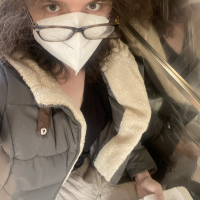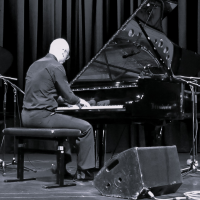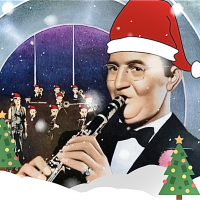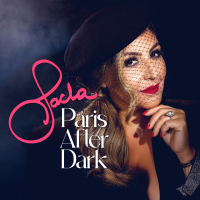Home » Jazz Musicians » James P. Johnson
James P. Johnson
Back during the heyday of ragtime piano (pre-1920), James P. had become a part of the famed "Harlem music scene," and was contributing to the distinctive Harlem piano style that differed melodically and harmonically from classic ragtime. Conventional ragtime had syncopation but lacked polyrhythm. James P. developed a strong and solid walking bass with his left hand and a rhythmic exciting treble with his right. His music flowed at an even tempo with considerable syncopation between the two hands. He superimposed conflicting rhythms in solos of symmetrical beauty. James Price Johnson was born in New Brunswick, N.J., in 1894. His mother taught him rags, blues, and stomps as soon as he was able to handles the keys on the parlor upright. When Jimmy reached 9 years of age, he started lessons with Bruto Giannini, a strict musician from the old country, who corrected his fingering but didn't interfere with his playing of rags and stomps. The Johnson family moved into New York City when Jimmy was 12, and early in his teens he became the "piano kid" at Barron Wilkin's Cabaret in Harlem. It was at Barron's that he met Charles L. (Lucky) Roberts from whom he derived his brilliant right hand. Later his solid bass was inspired by the work of Abba Labba, a "professor" in a bordello. Through the years James P. kept up his studying, and in the 1930s he began the study of orchestral writing for concert groups. James P., Lucky Roberts, Willie (The Lion) Smith, and the Beetle (Stephen Henderson), were familiar figures around "The Jungle" (on the fringe of San Juan Hill in the west 60s when this older Negro district was thriving before 1920.) They followed in the footsteps of Jack The Bear, Jess Pickett, The Shadow, Fats Harris, and Abba Labba. Here and in the later uptown Harlem, the house rent parties flourished and the boys who could tinkle the ivories were fair haired. Willie The Lion recalled those days for Rudi Blesh as follows: "A hundred people would crowd into one seven-room flat until the walls bulged. Plenty of food with hot maws (pickled pig bladders) and chitt'lins with vinegar, beer, and gin, and when we played the shouts everybody danced." Long nights of playing piano at such festivities gave James P. plenty of practice at the keyboard. There were two younger jazz pianists who followed Jimmy Johnson around during these Harlem nights.
Read moreTags
Lost and Found, Part 4: James P. Johnson, Ella Fitzgerald, Lennie Tristano & Hasaan Ibn Ali

by Larry Slater
This is the fourth and final hour of recent historic jazz discoveries. There are some amazing and inspiring stories of jazz sleuths who pulled out all the stops to discover long-lost music. The story of James P. Johnson's lost manuscripts ranks right up there with the most dedicated jazz archeologists. James P. Johnson is best known as the inventor of stride piano and the composer of the singular piece of music that came to symbolize the 1920s in ...
Continue ReadingUp In Harlem - Stride (1921 - 1939)

by Russell Perry
In the last hour, we listened to several of the bands associated with New York, with an emphasis on the new large ensemble form, the jazz orchestra. In this hour we'll stick with New York, but focus in on the piano music of Harlem—"Stride." We are joined in this hour by Art Wheeler, pianist, producer, composer and educator. In his History of Jazz, Ted Gioia writes, “It is not going too far to suggest that piano was to ...
Continue ReadingNewk with Bud, a Trip in the Way-Back Machine & More

by Marc Cohn
We start with our usual dose of twenty-first century music (Marsico should be better known in the States!). And there's a quiz for you in tracks two and three; so pay attention! Then, it's 19-year-old Sonny Rollins with Bud Powell from '49, followed by a walk in the Fall air where the original French lyrics to “Autumn Leaves" yield to a compare and contrast with Herbie Hancock (with Miles) versus Keith Jarrett. Classic sounds from years ...
Continue ReadingEarl Hines, Pete Johnson and James P. Johnson: Reminiscing at Blue Note – 1939-43

by Marc Davis
In the beginning, there was the piano--if not in jazz generally, then definitely at Blue Note Records. From the start, Blue Note founder Alfred Lion was obsessed with the piano. Blue Note's very first recordings, in 1939, were 19 tunes by boogie-woogie pianists Meade “Lux" Lewis and Albert Ammons. You can hear them all on one fabulous CD called The First Day. Later that same year, Lion recorded more piano favorites by all-time greats Earl “Fatha" ...
Continue ReadingJames P. Johnson: The Original James P. Johnson: 1942-1945 piano solos

by Mike Neely
The Original James P. Johnson goes a long way toward summing up the early history of jazz piano. The early jazz singer Ethel Waters stated, “ All the hits you hear, now as then, originated with musicians like James P. Johnson . . . the rest of the hot piano boys . . . just followers and protegees of that great man, Jimmy Johnson."
This superb disc of Johnson piano solos was recorded by Smithsonian Folkways, from 1942 to1945. There ...
Continue ReadingJames P. Johnson And “Carolina Shout”

Source:
Rifftides by Doug Ramsey
Today, February 2, is the birthday of James P. Johnson (1894-1955), who developed stride piano as an art form within an art form. In his time, piano cutting contests were proving grounds—most often in Harlem apartments—where competing pianists showed their stuff. If James P was playing, their stuff was likely not to be good enough. Johnson’s most famous composition was “Carolina Shout,” a test of a pianist’s swing, power and rhythm. He recorded it several times. Many pianists, critics and ...
read more
Shelly Berg plays James P. Johnson This Week on Riverwalk Jazz

Source:
Don Mopsick
Shelly Berg, pianist and Dean of the Frost School of Music at the University of Miami, plays the music of James P. Johnson with the Jim Cullum Jazz Band this week on Riverwalk Jazz. The show is distributed in the US by Public Radio International, Sirius/XM and can be streamed from the Riverwalk Jazz website here. Pianist James P. Johnson is a little-known genius of American music. His style of piano playing became known as 'stride' and was a bridge ...
read more
Steve Lehman Live in New Haven and Remembering James P. Johnson

Source:
See! Hear! by Richard Kamins
Hard to believe it's been 7 years since Steve Lehman graduated from Wesleyan but not surprising when one sees how busy he's been. The alto saxophonist and and composer has studied with Jackie McLean, Anthony Braxton, Jay Hoggard, Ron Kuivila and George Lewis, has taught in Paris and is currently working on a Ph.D (as well as teaching) at Columbia University in New York City.He leads his own ensembles and has recorded for CIMP, Clean Feed, and Pi ...
read more
James P. Johnson's Last Rent Party! October 4th, 2009 @ Smalls Jazz Club

Source:
Jason Byrne, Red Cat Publicity
October 4th, 2009 1:00 PM to 9:00 PM @ Smalls Jazz Club 183 West 10th Street @ 7th Ave South New York City, 10014 smallsjazzclub.com James P. Johnson, the father of stride piano, the composer of The Charleston and The Carolina Shout, and one of the founders of modern jazz piano, lies, shockingly, in an unmarked grave in Maspeth, Queens, Mt. Olivet Cemetery. Please join the James P. ...
read more
Ellington Uptown: Duke Ellington, James P. Johnson and the Birth of Concert Jazz

Source:
Michael Ricci
By Daniel Kassell In the first Chapter “On Tone Parallels to Harlem" John Howland states the premise that Symphonic Jazz of the 1920's influenced “a wide variety of American musical traditions" covering an awful lot of ground but stipulating it was merely “a minor footnote" in its own time.
Mr. Howland writes, “Why our we to take note of it now?" Because George Gershwin's 1924 performance of “Rhapsody in Blue" with Paul Whiteman's Orchestra in New York City's Aeolian Hall ...
read more







































